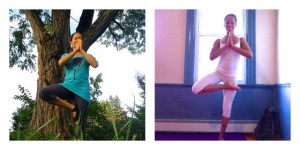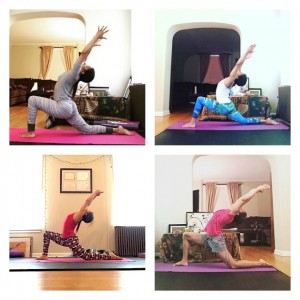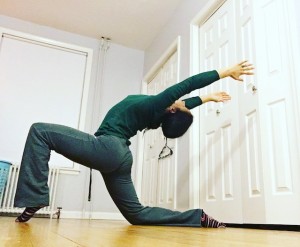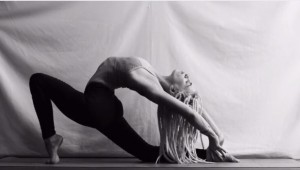 In a world where technology is advancing so rapidly that computing power doubles every two years and a new, more powerful iPhone is released every autumn, we have grown to expect our own personal transformation will occur just as swiftly. Wanna-be wellness entrepreneurs are promised that, with this or that expensive program, we can build a highly profitable health or life coaching business in just 90 days. Exercise regimens suggest that we non-runners can learn how to train for a marathon in three months–or, if we really push ourselves, just one. A dizzying array of diet plans give us the hope that we can lose 10 or more pounds of fat in two weeks or less. And on Instagram, dozens of yoga challenges each month set the high expectation that we will learn how to do a handstand or split in just four weeks by mirroring 30 sequential poses modeled by the already advanced yogis who serve as hosts. Two pictures shown side-by-side of seemingly the same person tell us that these tremendous physical transformations happened in just weeks or months, and we so strongly want to believe that this can be us too.
In a world where technology is advancing so rapidly that computing power doubles every two years and a new, more powerful iPhone is released every autumn, we have grown to expect our own personal transformation will occur just as swiftly. Wanna-be wellness entrepreneurs are promised that, with this or that expensive program, we can build a highly profitable health or life coaching business in just 90 days. Exercise regimens suggest that we non-runners can learn how to train for a marathon in three months–or, if we really push ourselves, just one. A dizzying array of diet plans give us the hope that we can lose 10 or more pounds of fat in two weeks or less. And on Instagram, dozens of yoga challenges each month set the high expectation that we will learn how to do a handstand or split in just four weeks by mirroring 30 sequential poses modeled by the already advanced yogis who serve as hosts. Two pictures shown side-by-side of seemingly the same person tell us that these tremendous physical transformations happened in just weeks or months, and we so strongly want to believe that this can be us too.
All of these claims can, on the surface, seem fairly reasonable–though admittedly challenging–since we are told that “science” demonstrates that we form a new habit after we commit ourselves to consistently doing a set task for 21 days. If we can just muster up the willpower to work through this period of self-enforced discipline, we remind ourselves, we’ll see the incredible results for ourselves. After all, that’s what the most successful people in the world–as so attractively displayed in glossy detail in our magazines and on our television and computer screens–do, right?
Wrong.
While the world around us constantly reinforces this belief that drastic change can and does occur rapidly, talking with people in the trenches reveals that the most accomplished people typically do not transform their lives into riveting success stories after a single, short sprint. In order to create true and lasting change, we need to stop believing that change always occurs overnight–or that it should. When we have too lofty, overly demanding and unrealistic expectations for ourselves, we can unconsciously thwart our sincere efforts. After a few weeks of putting in long hours at the office or gym, if we can’t yet see measurable progress that mirrors those digitally-altered transformation photos, we often give up and quit. Or if we do see change in the first few weeks or months, we may hit a plateau as we discover that our new behaviors are unsustainable in the long term.
“Change doesn’t happen overnight. There’s no button that’s pushed to magically alter everything. Change happens little by little. Day by day. Hour by hour.
It’s the ticking of a secondhand, moving painstakingly, as it makes its way around the clock. You don’t realize it until it’s already over, the minute gone forever, as you’re thrust right into the next one, the time still ticking away, whether you want it to or not.
Before long you have a hard time remembering the world as it once was, the person you were then, too focused on the world around you instead.
A world full of promise. A world full of excitement.”–J.M. Darhower
Starving ourselves, overtaxing our bodies and burning the candle on both ends in attempt to achieve unreasonably rapid change is detrimental to our physical health and mental wellbeing. While more than 75 million Americans spend a total of $60 billion each year to lose weight fast, three out of four diet attempts each year fail, according to Fooducate. Furthermore, we wind up nipping ourselves in the rear end as starvation mode sets in, and we put back on more pounds than we lost; or as exhaustion mode and illness sets in, and we’re forced to sit on the sidelines completely for weeks and months to make a full recovery; or as we hit financial, emotional and/or spiritual bankruptcy as our get-rich quick schemes turn out to cost us more financially, legally or ethically than they profit us. We lack the perspective that the most accomplished folks have, who realize the fruits of their labor may not be visible next month or even next year.
The successful put in countless hours every week for months and years on end. They acknowledge that there inevitably will be challenges and setbacks, illnesses and injuries, rebounds and all-out failures. Yet, what sets them apart from the rest of us is that, even in the face of such adversity, they keep showing up and putting in the effort. They have resilience during the difficult days, and they keep their eyes on the big picture. Focused on the long-term, passion fuels their vision, and their steadfast dreams direct their gaze ever forward and onward.
They realize that endurance and a steady pace over an extended period of time is required to see the results they most desire. Some even realize their efforts may not be fully recognized until the next generation builds upon their progress. And yet they continue to forge ahead.
We humans have a tendency to only notice change when it seems to occur in sudden and startlingly huge leaps. We transformed from a world lit solely by candles and kerosene lamps to the ubiquitous brightness of electric light bulbs and fluorescent lamps. Our not-so-distant ancestors traveled by horse and buggy, while we motor from place to place within the stylish steel cages motored by rechargeable batteries of electric cars. As late as the mid-1900s, people succumbed en masse to smallpox and polio here in the United States, but the World Health Organization declared a global eradication of smallpox in 1980, and the United Nations considers polio eradicated from all but three countries, as of 2016.
When looking back today, it can seem like these huge shifts in our society happen overnight, but they don’t really. While we might remember from our history books that Thomas Edison channeled the electrical charge of lightning through a dampened kite in the 18th century, we tend to be oblivious of English scientist William Gilbert’s work studying static electricity and the electric charge of friction in the 1600s; that he invented the first electrical measuring instrument. We tend to be ignorant of the electrostatic motors created in the 1740s, of the first, real rotating electric motor invented in 1834, of the discovery of the hydrogen fuel cell in 1838, and of the invention of the first real electric car way back in the 1880s. The first smallpox vaccine was developed in the 1790s, but it took more than a century and half to develop mass vaccination strategies, to collect surveillance data to better understand the nature of disease transmission and the effectiveness of immunity, to take containment measures to control the spread of disease and to develop the hygienic practices that helped prevent or minimize the development of these diseases in the first place. The widespread adoption and implementation of innovation can be much slower than we realize, whether we’re look at technology and medicine or fitness and sports.
In the 1950s, women’s gymnastics was a ballet-like sport, featuring graceful back walkovers on the floor and gentle cartwheels on the balance beam. In stark contrast, the women of the 2016 Olympics stunned with the groundbreaking double layout with a half twist in a floor routine by Simone Biles (who, incidentally, wasn’t actually the first to perform the move in a gymnastics competition) and Aly Raisman’s daring dismount off the four-inch wide balance beam with a Double Arabian–a back tuck with a half twist into a double front somersault. The muscular strength and dizzying finesse of modern-day gymnastics make the feminine dance of female gymnasts in the ‘50s seem incredible languid and quaint–a different sport altogether. Yet, a study of sports history reveals the important transitions it took to get from then to now.
https://www.facebook.com/mtvnews/videos/1220401541335361/
A floor routine from the 1960s looked decidedly more advanced than the previous decade, with a roundoff back handspring with a full twist. Then, in the 1972 Olympics, Olga Korbut revolutionized the sport by bringing a backward aerial somersault to the balance beam and a daring dive backwards from a standing position on the top bar of the uneven bars with a back flip dismount over the bottom bar. She even performed what yogis would recognize as a chin stand.
https://youtu.be/rOiKhuwzMKA?t=57s
In the late ‘70s and early ‘80s, Nadia Comaneci graced the scene, becoming the first female gymnast to do a double back somersault on the floor exercise. She was also the first gymnast period to earn a perfect score in Olympics, which she did with a flawless routine on the uneven bars, which hinted of the powerful grace of women gymnasts to come. She later became the first gymnast to perform an aerial walkover and aerial cartwheel-back handspring tumbling pass. She also is given credit as the first gymnast to perform a double-twisting somersault dismount from the balance beam.
During the 80s, women gymnasts were doing this skill as a dismount off the balance beam or with an additional full twist on the floor. According to The Atlantic, gymnastic athletes began performing back-to-back tumbling passes on the floor, multiple aerial elements in a row and the now standard roundoff-back handspring entry on the vault. Then, media darling Mary Lou Retton, inspired by Comaneci, took center stage in the 1984 Olympics, becoming the first American gymnast to win gold and introducing the tenacity and muscular physique for which American gymnasts are now well-known.
Truly, it can be especially difficult to notice and celebrate the more subtle and gradual changes that happen to us and within us over time. Too many of us tend to ignore the many, small steps we take in the right direction toward our dreams and goals. Yet, it is important to slow down and pause periodically to recognize and appreciate the progress we’ve made.
Last night, for instance, I was doing my daily yoga practice when I found myself making a slight shift in my leg positioning in low lunge. This tiny, little alteration affected my whole body as I found myself able to bend my back further in this pose than I ever had before. Realizing this was an ah-ha moment, I quickly grabbed my phone to document how far back I was actually bending and reaching.
Today, as I sorted through older photos, I noticed that most of my practice of low lunge focused on sinking the hips and deepening the hip flexion in low lunge. I spotted one picture in 2016, however, where I had noted how open my upper body was in the pose. Many, more months passed before I awoke to how I had accomplished this. The reason I had so much awareness in lunge last night was because of the weeks and months I have dedicated to mindfully moving into and breathing into the pose daily. While the shift seemed sudden, I had actually been preparing and practicing for that moment for a very long time.

My final iteration of pose may not look like all that much compared to the incredible backbends in low lunge by other bendy yogis.

Yet it is proof positive to me that I am finally learning how to lead with an open heart, while remaining rooted to the earth – no small feat when living with the twisting, shaking and falling of dystonia. The intent of study and practice isn’t to reach perfection, as many would have you believe; nor is meant as a tool to compare yourself to someone else’s expression of said pose or action. Rather, it’s to demonstrate progress and improvement on your previous self, which is a never-ending and constantly evolving journey.


Leave a Reply